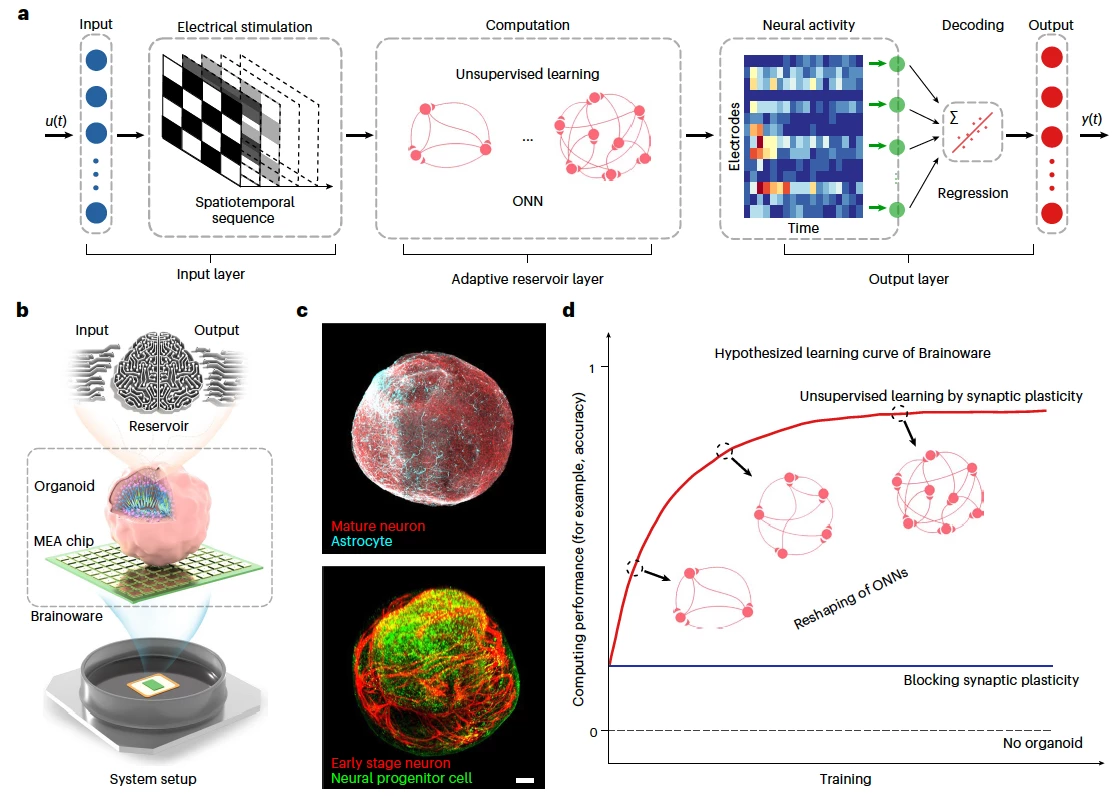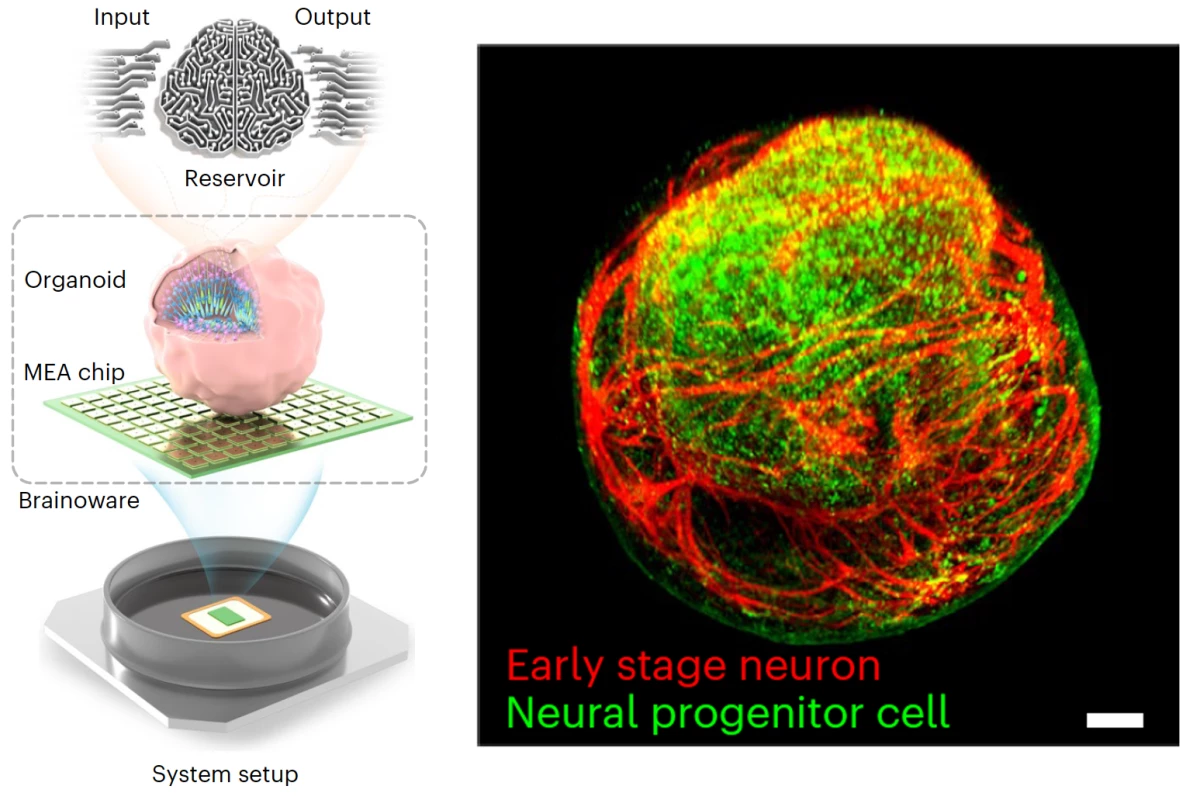Scientists have grown a tiny brain-like organoid out of human stem cells, hooked it up to a computer, and demonstrated its potential as a kind of organic machine learning chip, showing it can quickly pick up speech recognition and math predictions.
As incredible as recent advances have been in machine learning, artificial intelligence still lags way behind the human brain in some important ways. For example, the brain happily learns and adapts all day long on an energy budget of about 20 watts, where a comparably powerful artificial neural network needs about 8 million watts to achieve anything remotely comparable.
What's more, the human brain's neural plasticity, its ability to grow new nervous tissue and expand existing connective channels, has granted it an ability to learn from noisy, low-quality data streams, with minimal training and energy expenditure. What AI systems accomplish with brute force and massive energy, the brain achieves with an effortless elegance. It's a credit to the billions of years of high-stakes trial and error that delivered the human brain to the state it's in today, in which it's chiefly used to watch vast numbers of other people dancing while we're on the toilet.
But if the brain's such a powerful learning computer, and all it's doing in our skulls is responding to electrical signals from our senses, why not just wire the dang thing up in a jar and see if it can replace neural machine learning chips? Well, most people need their brains – the rest of you know who you are – but brain cells can be created easily enough out of pluripotent stem cells, in petri dishes, and they have a natural tendency to self-organize and differentiate themselves into useful structures like you'd find in a developing brain.

Hence, we are now living in the era of the biocomputer, a cyborg-esque confusion of silicon and living tissue. In September, we spoke to Cortical Labs, which stunned the world in 2022 by growing 800,000-odd brain cells onto a silicon substrate, and teaching the resulting "DishBrain" computer to play Pong, among other things.
Now, Indiana University researchers have taken a slightly different approach by growing a brain "organoid" and mounting that on a silicon chip. The difference might seem academic, but by allowing the stem cells to self-organize into a three-dimensional structure, the researchers hypothesized that the resulting organoid might be significantly smarter, that the neurons might exhibit more "complexity, connectivity, neuroplasticity and neurogenesis" if they were allowed to arrange themselves more like the way they normally do.
So they grew themselves a little brain ball organoid, less than a nanometer in diameter, and they mounted it on a high-density multi-electrode array – a chip that's able to send electrical signals into the brain organoid, as well as reading electrical signals that come out due to neural activity.
They called it "Brainoware" – which they probably meant as something adjacent to hardware and software, but which sounds far too close to "BrainAware" for my sensitive tastes, and evokes the perpetual nightmare of one of these things becoming fully sentient and understanding its fate.
Then, they started treating it like a neural machine learning chip, putting it in a "reservoir computing" framework. This is a very weird kind of "black box" idea within neural network computing, in which a "reservoir" – which could be anything from some virtual software system, to lasers, to a literal bucket of water – is used to "map input signals into higher dimensional computational space through the dynamics of a fixed, non-linear system," according to Wikipedia.

Neither you nor I need to pretend we understand what that means, so we can all relax and proceed without guilt. The researchers hooked the Brainoware organoid computer chip into a system, treating it as an "adaptive living reservoir," made sure the mini-brain was responding to electrical inputs in a suitably non-linear fashion, checked that it had some kind of memory in effect, figured out how to feed in spatial data in a grid array, and then started some unsupervised learning tests.
They focused on two areas: firstly, speech recognition; some 240 audio clips of adult males speaking Japanese were fed into the Brainoware chip after being converted into electrical signals. Remarkably, on day zero, the organoid was able to distinguish – just from a single vowel sound – which of eight different people were talking at about 51% accuracy. Two days later, that had risen to 78%.
They then moved to mathematics, getting the Brainoware chip to "predict a Hénon map, which is a typical nonlinear dynamic system with chaotic behavior." This involved an extra layer of abstraction, as each 200-point, 2D Hénon map had to be converted into a one-dimensional, spatiotemporal electrical signal that could be fed into the brain tissue. In two days, it increased its accuracy at predicting where a given point would be from 0.356 to 0.812.

To flex on team silicon, they also threw the same problem at some artificial neural networks, finding that it "notably outperformed ANN without a long short-term memory unit," and "showed slightly lower accuracy that ANN with LSTM... decreasing the training times by >90%."
The team concluded that three-dimensional human brain organoids like this can definitely form functional neural networks and operate as a new class of machine learning hardware, while naturally addressing the time, energy consumption and heat production challenges that face artificial machine learning chips. They're interested in upgrading the idea with soft needle-style electrodes implanted into the organoid's brain tissue, which would give input/output access to a greater number of neurons than the current device, which only has contact with the outside of the brain cell ball.
There are limitations, though, as you might imagine when working with living tissue. Firstly, you have to find a way to grow them en masse, and keep them alive and healthy, which is not really something Nvidia has to worry about. They can also be very different one from another, which raises the somewhat macabre question of whether brain cells grown from neuroscientist stem cells might work better than ones taken from, say, Sexyy Red fan club members.
The team also notes that while the organoid chips consume very little energy as they work, the life support systems do eat up some of the savings – although the researchers believe that if this sort of thing took off, these systems could develop quickly.
And finally, much like the team at Cortical Labs, this team really has no clear idea what to do about the ethics of creating micro-brains out of human neurons and wiring them into living cyborg computers. “As the sophistication of these organoid systems increases, it is critical for the community to examine the myriad of neuroethical issues that surround biocomputing systems incorporating human neural tissue," wrote the team. "It may be decades before general biocomputing systems can be created, but this research is likely to generate foundational insights into the mechanisms of learning, neural development and the cognitive implications of neurodegenerative diseases."
These are indeed strange waters we're entering as technology accelerates seemingly beyond all control in 2023. Lord knows what 2030 is going to look like, let alone 2050.
The paper is available in the journal Nature Electronics.
Source: Scimex





